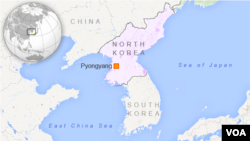The United States has expressed concern about North Korea's artillery fire toward South Korea, which retaliated by firing its own artillery in their latest flareup of cross-border violence.
State Department spokesman John Kirby said Thursday that such "provocative actions" by the North only heighten tensions. He urged Pyongyang to refrain from actions and rhetoric that threaten regional peace and security.
U.S. officials say they are closely monitoring the situation.
The artillery exchange took place earlier Thursday along the countries' western border and amid ongoing annual joint U.S. and South Korean military exercises, which began on Monday and which North Korea condemns as preparation for war.
North Korea has asked the U.N. Security Council to hold an urgent meeting to discuss the joint U.S.-South Korean military exercises. The North's U.N. Ambassador, Ja Song Nam, made the request in a letter sent to the council on Wednesday.
Pyongyang has repeatedly asked the Security Council to discuss the annual drills.
No Casualties
The South's defense ministry said Thursday's artillery exchange began when North Korea fired shells at South Korean military positions. The South responded by launching dozens of 155-millimeter artillery rounds at the North, said the ministry.
A South Korean news agency reported the shells appeared to land in a mountainous area near a South Korean military base in the town of Yeoncheon, 60 kilometers north of Seoul.
No casualties were reported.
The South's defense ministry said the North later warned Seoul in a letter that it would take further military action if the South did not stop anti-Pyongyang propaganda broadcasts along the border within 48 hours. South Korean officials said the broadcasts would continue.
North-South relations have been particularly strained after Seoul accused Pyongyang of planting landmines that exploded this month, wounding two South Korean soldiers.
South Korean authorities initially ordered a civilian evacuation in Yeoncheon.
The Paju region where the landmine incident occurred was added to the evacuation list, as was the western Island of Kanghwa.
After the landmine incident South Korea restarted cross-border propaganda broadcasts via loudspeakers that had sat dormant for over a decade. North Korea responded with its own propaganda broadcasts.
North Korea denied any involvement in the landmine attack, and last week threatened "all-out military action of justice to blow up all means for anti-North Korean psychological warfare" if South Korea did not immediately stop the broadcasts.
Several reports have suggested that the North Korean artillery fire was directed at or near the propaganda speakers.
Seoul raises alert level
South Korea has raised its military readiness alert to its highest level, Jindogae 1, indicating immediate danger, imminent attack or invasion.
South Korea’s National Security Council met with President Park Geun-hye about North Korea artillery shelling in border area.
The exchange of fire was the first between the two Koreas since last October, when North Korean soldiers approached the military border and did not retreat after the South fired warning shots, the South Korean Defense Ministry said at the time. The North's soldiers fired back in an exchange of gunfire that lasted about 10 minutes, with no casualties.
William Gallo, Mike Richman and VOA Seoul Correspondent Brian Padden contributed to this report









